I’m running out of Munich pictures, so you’ll see some Lisbon pictures mixed in with today’s post, which touches on three heavy or philosophical topics.
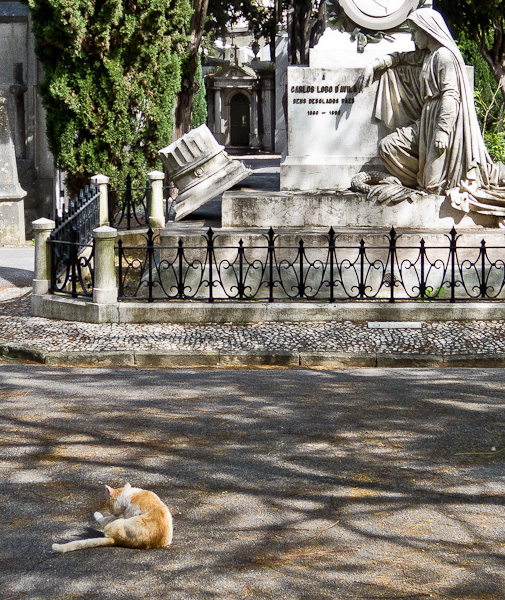
[Creepy cat in Lisbon graveyard.]
(1) The Germans are, as one would expect, very thorough, and very attentive to rules. One doesn’t cross an empty street if the pedestrian “Walk” light isn’t on. If I show my ID to a museum ticket-seller to get the senior rate, she’s actually going to read the month, day and year of my birthday. When the woman in the grocery-store hands me my bag of food, she admonishes me to hold both handles of the bag lest I spill my purchases. Another woman advised me about how to heat up a Munich-style white hotdog without (auugh!) bursting it. But there’s a cheerful, agreeable quality to all this, a kind of “We’re playing this game together,” attitude.

[Balloon used for lamp fixture in Lisbon church.]
Walking around, I keep admiring how attractive, tidy and cultured the Germans are. In the course of my life, I’ve lived in Germany for about three years, and I’m comfortable here. But, having been away for so long now, I’m also sensitive to the sinister side of Germany—I’m referring of course to the Nazis.
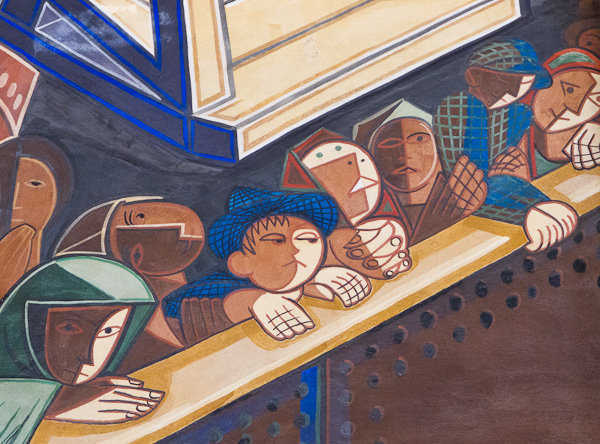
All three of my uncles were officers in the German army—they had no choice but to enlist. My uncle Rudolf von Bitter died on the Russian front, the other two were captured and served time in Russian and English prison camps. My grandfather Rudolf von Bitter is said to have helped the underground resistance against the Nazis. The family sent my mother to America in 1937 so that at least one of them would survive the coming war.
I’m not blindly on the Germans’ side— we even have a few Jewish ancestors far up in our German family tree, and if the Third Reich had gone on indefinitely, my relatives might have ended up in the death camps. Even so, it’s not reasonable to assume that typical Germans are racists and heartless killers—any more than it’s reasonable to think the same about all Americans in the wake of Hiroshima, say, or My Lai.

[A nice patch of wall in Sintra, Portugal.]
But still. Why did the Germans have to act so terribly in the Second World War? It’s undeniable that the Nazis had huge popular support. I found myself wishing that it were somehow possible to change history so that the horror had never happened. I was wishing that my race could be cleared of blood-guilt.
I talked this over with my cousin Rudolf. He, of course, has thought about these questions quite a bit. I’ll condense and paraphrase his remarks.
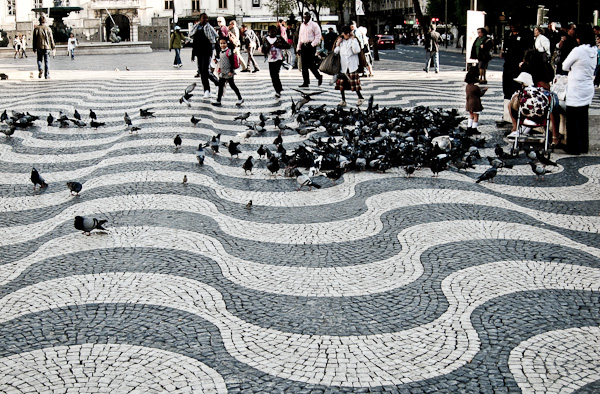
[Tiled Rossio Square in Lisbon.]
“If you are accused of a crime, or if the group you belong to is accused, it’s better to begin by admitting your guilt. Denial leads nowhere. Hitler is part of the German character. And, yes, we have our fine culture as well, for instance, Goethe. But to imagine that we could somehow keep the Goethe and get rid of the Hitler is a lie. G and H. Next to each other in the alphabet. I also think of Goethe’s story, Der Zauberlehrling (The Sorcerer’s Apprentice); a meditation on the dark side of intellectual and technological power.”

[Chuch tile with holy candles in Lisbon.]
No real answer.
(2) Looking for things to do that didn’t involve walking, I went to a concert in a former imperial church, a sequence of seven Haydn sonatas based on Jesus’s “Seven Last Words,” these being the seven direct quotes of Him that appear in the Gosper of Saint Luke.
My favorite of these is where the Good Thief says, “Lord, remember me when you come into your kingdom.” And Jesus seems to agree with that, and says, “Verily I say unto you, today you shall be with me in paradise.”
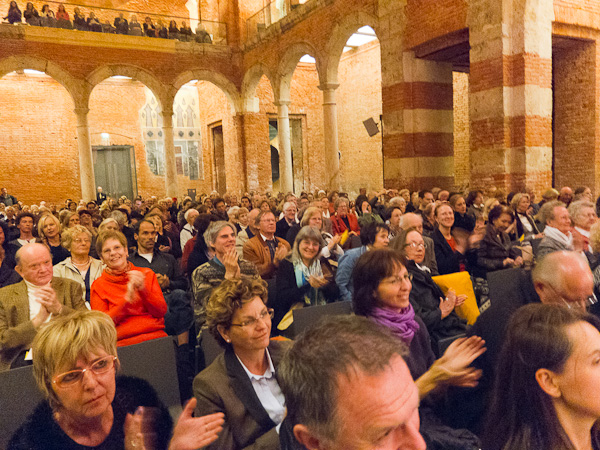
[German concert crowd.]
I once had an interesting discussion of this passage with my old science-writer mentor, Martin Gardner. Some religious sects have take the exchange between Jesus and the Good Thief to mean that your soul isn’t in fact immortal on its own, but is, rather, a pattern of information that God stores in His memory so that He can resurrect you. Sometimes the word “soul sleep” is associated with this notion, but if you try Googling or looking in Wikipedia, you find a bewildering gamut of variations on this (heretical by some lights) doctrine.
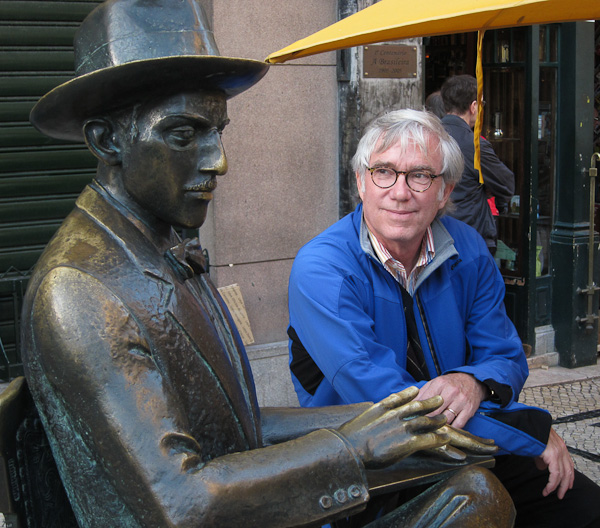
[Me in Lisbon with a statue of poet Fernando Pessoa]
Keeping it simple, to me the Thief/Jesus exchange suggests that the soul can in fact be represented as software, that is, as a pattern of information that God (or a sufficiently large computer memory) can store.
“Remember me!” What a great request.

(3) On my last day, I rode Rudolf’s bike to the Neue Pinakothek, a Munich museum with 19th and early 20th century art. The Neue Pinakothek had a nice Ferdinand Hodler, shown above, and a couple of good van Goghs. Studying his works in awe, I started thinking it might be fun to try some paintings in which I use enough extra paint to build up an impasto relief of brush strokes.
I always wonder why van Gogh killed himself. Wouldn’t you be happy if you could paint that well? I guess he was out there alone on some kind of unbearable edge. It’s hard to visualize just how crazy some artists are. It occurs to me to do an SF move on van Gogh—that is, to imagine a future kind of art with its own kind of crazy artist. The notion of future art forms fasinates me.
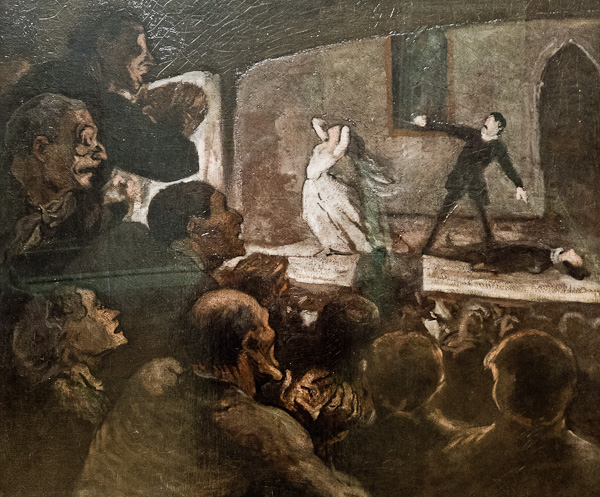
I also noticed an Honore Daumier painting of some excited folks goggling at an onstage drama. Antonio Damasio argues in his book The Feeling of What Happens, that the essence of consciousness is to have, get this, a mental image oneself watching one’s life unfold. At level 1, we simply are em embedded in life, we’re like the actors on the stage. At level 2, we can stand aside a bit, and see life as a spectacle. At level 3, which is where Damasio says consciousness kicks in, we are aware of ourselves as detached observers of life’s passing scene. You’re looking at the Daumier painting of yourself. As I discuss in my tome, The Lifebox, the Seashell and the Soul, (see the online version of the relevant passage here), all of Damasio’s levels can, at least in principle, be modeled in computer software.

[Egyptian style rings at Gold and Silver Market in the Scwabing district of Munich. Like language tokens.]
After the museum, I sat in their very pleasant outdoor cafe for a long time, eating while reading Raymond Chandler, The Big Sleep, a book I’d dug up at Rudolf’s apartment—I think his daughter had it assigned for her English class. After two and a half weeks, I was kind of done with doing something touristic every minute. I was edging towards the next level—of simply living abroad.

It had been awhile since I’d read Chandler, and I’d forgotten just how wonderful a writer he is. His use of language is exquisite, as in his thumbnail sketches of his characters’ personalities. And his dialog is wonderful, rife with odd-ball 1930s slang—probably nobody ever really talked that way, but the patois makes for a wonderful seamless level of discourse that holds his worlds together.
From Farewell My Lovely: “I felt like an amputed leg.” “…my bank account was still trying to crawl under a duck…”

[Water works building near dam in Los Gatos, California]
Chandler’s slang reminds of the way that I often make up a standard slang for my SFictional worlds. I’ve learned that it works best if the words in this alternate language are short, easily spelled, and easy to say, like the well-polished words in actual human speech. Sometimes one can repurpose an existing word, but it’s often better to invent a previously unused word—if you scratch around a bit, you’ll find there’s really quite a few good and usable syllables that don’t happen to be standard English words. In picking a made-up word, you have to be keenly aware of the word’s associations, that is, if it sounds a bit like some real word.

[Theatiner church in Munich.]
Anyway, my time in Munich finally ran out and, next step, next step, next step, I called a taxi to pick me up at 5 am to take me to the station to catch a suburban train to the airport, etc. And now polishing these notes, I’m looking across my desk at our cozy backyard.
Thank you, Cosmos! It was a good trip.









May 3rd, 2011 at 2:52 pm
About Van Gogh…he killed himself probably because the ear infection he had drove him crazy! Who knows for sure? If only you were in a time machine and could go back to then and ask.
May 4th, 2011 at 12:38 am
You have not been to the Pinakothek der Moderne? With all those fantastic Expressionists? Marc, Kandinsky, Nolde… Just the other side of the Museum of Cristalls.
Some more pictures of Munich? Watch here: http://de.sevenload.com/alben/PRepe5P
May 4th, 2011 at 11:27 am
Die Allerheiligen-Hofkirche, gebaut 1826 -1837 von Leo von Klenze im Auftrag von König Ludwig I.
Not imperial, only royal.
destroyed, rebuilt and reopened 2003 – I’ve not yet been there.
Klenze is responsible for Munich’s neo-classical face.
It’s a pity most Americans follow the traces of this Hitler – who is not worth being followed – instead of admiring the architecture and art of former periods or even of modern buildings like the Pinakothek der Moderne, the Academie, the Olympic Parc …
May 4th, 2011 at 9:51 pm
I’m glad, I caught your recent blog posts. For having read your novel White Light in the nineties, which accounts for some aspects of your private life in the sixties and finding very now “autobiographical” notes on your Munich cousin and your German background, this creates a strange but extremely enjoyable “literary effect”. Please excuse my pretentiousness, but I would call it a Proustian effect, because Proust invites us to follow his “leading characters” through half a century. It doesn’t feel important, whether this “effect” occurs within book covers solely or rather one half printed and one half blog post.
May 12th, 2011 at 7:38 pm
Hey Rudy!
Once again, really nice photos (I particularly like the old mossy wall contrasted with the view of houses, the colors are mesmerizing). I really think you should do a future artist type story. Done realistically, this idea has a lot of potential. I remember reading somewhere that the story Phil Dick was working on before he died was about a composer of the future who had a chip implanted in his brain by aliens; allowing him to compose incredibly original music. I’ve also toyed around with the idea of an artist of the future in my graphic novel work, getting 120 pages in before abandoning the story. I assume you’ve heard of the computer scientist Jaron Lanier? He has some convincing ideas of a virtual reality kind of thing which would allow your avatar to morph into whatever it is you’re thinking. The idea I was playing around with was similar to this concept. “Artists” of the future would be able go about their daily lives literally having their daydreams stored for further use, no need to take notes or make sketches. Also, I was thinking that artists (or scientists, musicians etc.) would be able to work together in a virtual environment, allowing their projected streams of consciousness to intermingle and build on each other to produce new concepts. Given your wild imagination, you could probably think of many awesome and far more convincing future scenarios for this type of story. If you decide to do something like this, I’m definitely looking forward to it.
Cheers!